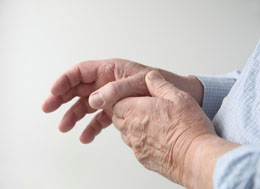Arthritis is a medical condition that affects the joints of the body. This article provides information on the symptoms that occur when arthritis affects the thumbs.

Osteoarthritis and rheumatoid arthritis are known to be common forms of arthritis (inflammation of one or more joints in the body). While the former is characterized by the degeneration of cartilage, the latter is an autoimmune disease that causes pain, swelling, stiffness, and loss of function in the joints. Thumb arthritis, which is also known as basal joint arthritis, occurs when the joint that lies between the wrist and the base of the thumb becomes inflamed. It is believed that repetitive use of the thumb could lead to wear and tear of cartilage, which cushions the ends of the bones that form the thumb joint. Aging, injury, or muscle weakness could also be contributing factors. If the cartilage wears down, the bones would rub against each other. Friction between the bones would give rise to pain.
Signs and Symptoms
The primary symptom that indicates the occurrence of arthritis in thumbs is pain that originates from the affected area. The affected individual is likely to experience pain on performing actions such as gripping or holding objects. Pain is likely to arise on performing activities that involve the use of thumb and forefinger. Common examples of such actions are unscrewing a large bottle cap or unlocking a lock with a key. As the condition worsens, pain might strike even if the thumb is not in use.
Other symptoms which may accompany pain include swelling and tenderness of the base of the thumb. The same area may also feel stiff, which in turn, would decrease the range of motion. The thumb might appear to be deformed and the affected individual might experience a feeling of decreased strength while gripping or grabbing any object.
The intensity of symptoms usually depend on how severe the condition is, and how often is the thumb being used. For instance, a foosball player's ability to get a proper grip on the playing rods will get adversely affected with time. So in such a case, unfortunately, the person would have to take a long break from this sport in order to let his thumb improve.
Treatment Measures
The treatment would involve the use of oral non-steroidal anti-inflammatory drugs, painkillers, or steroid injections to reduce pain and inflammation. Steroid shots might prove helpful in keeping the symptoms at bay for a longer time. The objective of the treatment is to increase the range of motion of the joint. The use of splints might be recommended to limit thumb movement, thereby giving the affected part some rest. Surgical treatment is considered as a last resort, when conservative treatments do not help. Going for physiotherapy sessions will also help to improve the thumb's range of motion. Also, the affected person must avoid performing activities that seem to aggravate the pain. Application of heating pads and cold packs might also help reduce swelling and pain.
Timely diagnosis and treatment is extremely essential when it comes to any disease, and it applies to thumb arthritis as well. Medical help must be sought by anyone who has been experiencing the aforementioned symptoms. Following the aforementioned self-care measures and the guidelines recommended by the doctor will certainly help in alleviating the symptoms to a great extent.
Disclaimer:
The information provided in this article is solely for educating the reader. It is not intended to be a substitute for the advice of a medical expert.


 Osteoarthritis and rheumatoid arthritis are known to be common forms of arthritis (inflammation of one or more joints in the body). While the former is characterized by the degeneration of cartilage, the latter is an autoimmune disease that causes pain, swelling, stiffness, and loss of function in the joints. Thumb arthritis, which is also known as basal joint arthritis, occurs when the joint that lies between the wrist and the base of the thumb becomes inflamed. It is believed that repetitive use of the thumb could lead to wear and tear of cartilage, which cushions the ends of the bones that form the thumb joint. Aging, injury, or muscle weakness could also be contributing factors. If the cartilage wears down, the bones would rub against each other. Friction between the bones would give rise to pain.
Osteoarthritis and rheumatoid arthritis are known to be common forms of arthritis (inflammation of one or more joints in the body). While the former is characterized by the degeneration of cartilage, the latter is an autoimmune disease that causes pain, swelling, stiffness, and loss of function in the joints. Thumb arthritis, which is also known as basal joint arthritis, occurs when the joint that lies between the wrist and the base of the thumb becomes inflamed. It is believed that repetitive use of the thumb could lead to wear and tear of cartilage, which cushions the ends of the bones that form the thumb joint. Aging, injury, or muscle weakness could also be contributing factors. If the cartilage wears down, the bones would rub against each other. Friction between the bones would give rise to pain.